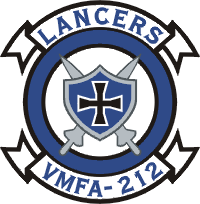
Marine Fighter Attack Squadron 212 (VMFA-212) was a United States Marine Corps F/A-18 Hornet squadron. Most recently known as the "Lancers", the squadron was last based at Marine Corps Air Station Iwakuni, Japan and fell under the command of Marine Aircraft Group 12 (MAG-12) and the 1st Marine Aircraft Wing. VMFA-212 has an extensive combat history having participated in combat operations during World War II, the Korean War, Vietnam War, the Gulf War, and Operation Enduring Freedom. Due to a re-organization within Marine aviation, the squadron was deactivated in 2008.
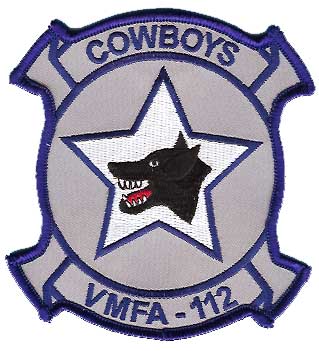
Marine Fighter Attack Squadron 112 (VMFA-112) is a reserve United States Marine Corps McDonnell-Douglas F/A-18 Hornet squadron. The squadron is based at NASJRB Fort Worth, Texas and falls under the command of Marine Aircraft Group 41 (MAG-41), 4th Marine Aircraft Wing. Their tail code is MA. During World War II the squadron saw extensive action throughout the Pacific Theater of Operations especially at the Battle of Guadalcanal as part of the Cactus Air Force. By the end of the war, its 140 air-to-air kills ranked it third among Marine Corps squadrons.
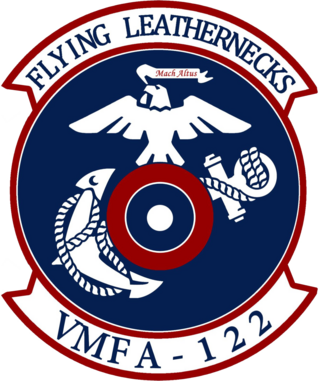
Marine Fighter Attack Squadron 122 (VMFA-122) is a United States Marine Corps fighter attack squadron flying the F-35B Lightning II. The squadron is based out of Marine Corps Air Station Yuma, AZ and falls under the command of Marine Aircraft Group 13 (MAG-13) and the 3rd Marine Aircraft Wing. The squadron nickname is the "Flying Leathernecks," and their traditional radio call sign is "Nikel". On 14 November 2017, VMFA-122 opened a new chapter of their history, transitioning from the McDonnell Douglas F/A-18C Hornet to the Lockheed Martin F-35B Lightning II and moving from MCAS Beaufort and MAG-31, 2nd MAW to MCAS Yuma and MAG-13, 3rd MAW.

Marine Fighter Attack Squadron 333 (VMFA-333) was a United States Marine Corps fighter squadron consisting of F/A-18 Hornets. Known as the "Fighting Shamrocks" and "Trip Trey", the squadron participated in action during World War II, the Vietnam War and Operation Desert Storm The squadron’s aircraft were easily recognizable by the row of three shamrocks painted on the vertical stabilizers of their aircraft. They were decommissioned on 31 March 1992.

Marine Fighter Attack Squadron 142 (VMFA-142) was an aviation unit of the United States Marine Corps Reserve that was active from 1942 to 2008. At the time of its inactivation, the squadron was based at Naval Air Station Atlanta, Georgia and fell under the command of Marine Aircraft Group 42 (MAG-42), 4th Marine Aircraft Wing. Due to a re-organization within Marine aviation, the squadron moved to Naval Air Station Fort Worth Joint Reserve Base, Texas and was placed in a cadre status under Marine Aircraft Group 41.
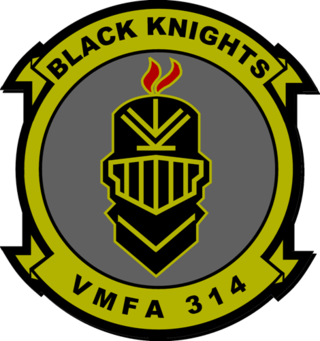
Marine Fighter Attack Squadron 314 (VMFA-314) is a United States Marine Corps F-35C Lightning II squadron. The squadron, known as the "Black Knights", is based at Marine Corps Air Station Miramar, California and falls under the command of Marine Aircraft Group 11 (MAG-11) and the 3rd Marine Aircraft Wing, but deploys with the US Navy's Carrier Air Wing Nine (NG).
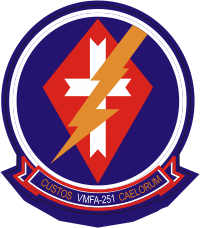
Marine Fighter Attack Squadron 251 (VMFA-251) was a United States Marine Corps F/A-18 Hornet squadron. Known as the "Thunderbolts", the squadron was deactivated on 23 April 2020. If current plans hold, the squadron is to be re-activated by 2025 as a F-35C Lightning II and based at Marine Corps Air Station Cherry Point, North Carolina.

Marine Fighter Attack Squadron 312 (VMFA-312) is a United States Marine Corps F/A-18C Hornet squadron. Also known as the "Checkerboards", the squadron is based at Marine Corps Air Station Beaufort, South Carolina and falls under the command of Marine Aircraft Group 31 (MAG-31) and the 2nd Marine Aircraft Wing. The Radio Callsign is "Check."

Marine Aircraft Group 41 (MAG-41) is a United States Marine Corps reserve aviation unit based at Naval Air Station Joint Reserve Base Fort Worth, Texas that is currently composed of one F/A-18C squadron, one KC-130J squadron, one C-40 squadron, one Northrop F-5 aggressor squadron based at Marine Corps Air Station Yuma, Arizona, one Marine Light Attack Helicopter Squadron at MCAS Camp Pendleton, one MV-22B squadron based at MCAS Miramar, one aviation logistics squadron and two wing support squadrons with multiple detachments throughout the United States.

Marine Fighter Attack Training Squadron 501 (VMFAT-501) is a training squadron in the United States Marine Corps, consisting of 27 F-35B Lightning II aircraft and serves as the Fleet Replacement Squadron. Known as the "Warlords," the squadron is based at Marine Corps Air Station Beaufort, South Carolina and falls administratively under Marine Aircraft Group 31 and the 2nd Marine Aircraft Wing. The squadron has assumed the lineage of VMFA-451 which was originally known as the "Blue Devils" and saw action during World War II and Operation Desert Storm. They were decommissioned on 31 January 1997.

Marine Fighting Squadron 111 (VMF-111) was a reserve fighter squadron in the United States Marine Corps. Nicknamed the "Devil Dogs", the squadron was one of the first aviation squadrons in the Marine Corps and gained national attention in the 1930s as the Marine Corps show unit. The squadron fought in World War II and was later transferred to the Reserves where they fell under the command of Marine Aircraft Group 41 (MAG-41) and the 4th Marine Aircraft Wing while stationed at Naval Air Station Dallas, Texas. They were decommissioned on 22 October 1965.

Marine Fighter Attack Squadron 334 (VMFA-334) was a United States Marine Corps fighter squadron. Known as the "Falcons", it was part of Marine Aircraft Group 15 and Marine Aircraft Group 33. The squadron participated in action during World War II and the Vietnam War and was decommissioned in 1971.
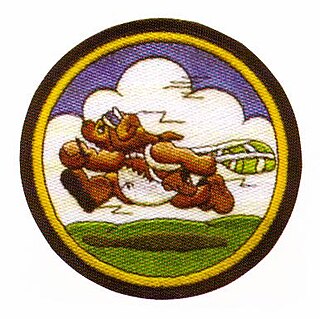
Marine Fighting Squadron 155 (VMF-155) was a fighter squadron of the United States Marine Corps in World War II. During the war, they flew the SBC Helldiver and, after reconstitution in 1943, the F4F Wildcat. Later in the War the squadron also flew the F4U Corsair. One of the squadron's pilots who went on to great distinction later in his career was Lieutenant John Glenn. The squadron, also known as "Ready Teddy" was deactivated shortly after the war and is still inactive.

Marine Fighter Squadron 123 (VMF-123) was a fighter squadron of the United States Marine Corps during World War II and later in the Marine Forces Reserve. Known as the "Flying Eight Balls," the squadron fought at Guadalcanal, Iwo Jima, and Okinawa and served as a training squadron for replacement pilots during the Korean War. The squadron was decommissioned on 31 October 1965 at Naval Air Station Los Alamitos.

Marine Transport Squadron 216 (VMR-216) was a reserve cargo squadron of the United States Marine Corps that was based out of Washington. Known as the "Bulldogs", VMR-216 started out as a fighter squadron and participated in numerous combat engagements in the Pacific Theater during World War II to include the Battle of Guam and the Battle of Iwo Jima. The squadron was decommissioned shortly after the end of the war but was reactivated in 1946 as part of the Marine Air Reserve. The squadron remained in the Reserve until being decommissioned on 21 December 1972.
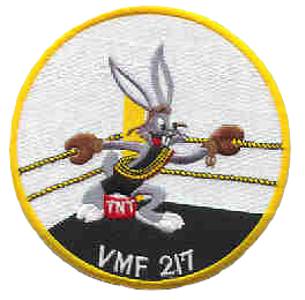
Marine Attack Squadron 217 (VMA-217) was a fighter squadron of the United States Marine Corps that was activated and fought during World War II. Known as "Max’s Wild Hares", they fought in many areas of the Pacific War including the Battle of Iwo Jima. Following the surrender of Japan, the squadron was deactivated on 10 March 1946. They were briefly reactivated as part of the Reserves but were again deactivated in 1964 and remain in an inactive status today.

Marine Fighting Squadron 511 (VMF-511) was a fighter squadron of the Marine Corps and Marine Forces Reserve during World War II and the Cold War which flew aircraft types such as the F6F Hellcat, F4U Corsair, and the F-8 Crusader. They were originally activated during World War II and fought during the Battle of Okinawa and the Battle of Balikpapan (1945). They specialized in close air support and during the course of the war were credited with only one plane shot down.

Marine Fighter Attack Squadron 124 (VMFA-124) was a flying squadron in the Marine Forces Reserve based out of Naval Air Station Memphis flying the Douglas A-4 Skyhawk. They were part of Marine Aircraft Group 42 and were decommissioned on 19 June 1999.
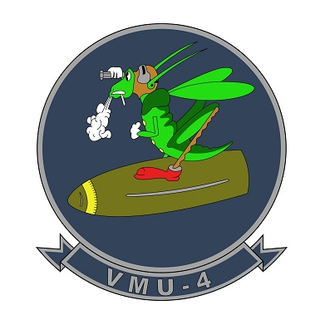
Marine Unmanned Aerial Vehicle Squadron 4 (VMU-4) is an unmanned aerial vehicle (UAV) squadron in the United States Marine Corps that operates the RQ-21 Blackjack. It is the fourth UAV squadron in the Marine Corps and the first in the reserve component. The squadron, nicknamed the "Evil Eyes", entered the force structure on 1 July 2010, when Marine Observation Squadron 4 (VMO-4) was reactivated and redesignated VMU-4.



















